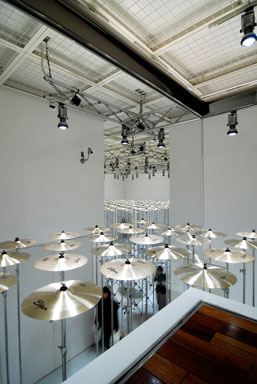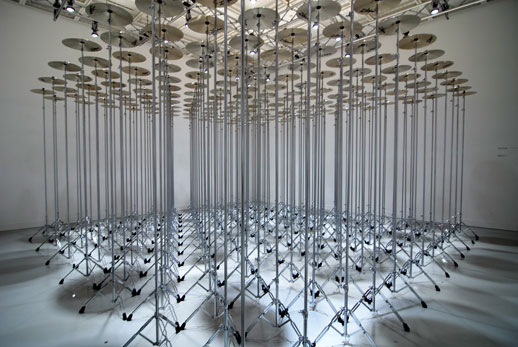Towering Silence
Makihara Taisuke’s striking installation at Shiseido Gallery is a showcase example of the Shiseido Art Egg project’s aim to give young, lesser known artists the chance to realize a concrete exhibition plan and fill the twin galleries. And Makihara’s installation certainly fills the space.

From the mezzanine floor that overlooks the gallery you are faced with a floating field of shiny bronze-gold discs. The initial confusion gives way to recognition: these are rows upon rows of drum cymbals, but they have been set atop stands over two metres tall. Once in the main gallery space, the number of densely packed cymbals, towering overhead, obliges the viewer to stick strictly to the walls. I immediately felt like Little Nemo in Slumberland; staring up at these oversized metallic mushrooms. Did they grow, or have I shrunk?
Makihara’s work is a conscious exploration of sensorial distortion. By reconfiguring the relationships we have to ‘everyday’ objects, in terms of scale and time, the sense of normality underpinning our experience of self is also ripe for scrutiny. In subtle ways, using objects and his own actions, the artist encourages a reconsideration of the spatial and temporal dimensions of our sensorial experience.But Makihara’s oversized forest of percussion, well out of reach, is rendered completely silent by its very size; the gallery is left as quiet as it is full. If one considers what might happen if one were to topple a couple of these towering cymbals, it becomes evident that although silenced, they retain a potent imminence. And yet when remembering the initial view of the cymbals from the balcony, there is an additional irony: from there the cymbals are too low to reach, whereas from here below, they are set too high.
It is interesting to consider why this ‘forest’ of stands should be set to the same height, and geometrically arranged in such a tight group. What would it be like to be able to weave through a slightly more open arrangement? Or what if the cymbal stands were different heights, rather than uniform? Aesthetics aside, perhaps logistical issues played a hand in these decisions. Surely it’s not simply a case of filling the gallery space? Adding such ‘texture’ to the installation would arguably detract from the sense of volume that Makihara achieves through repetition. Indeed, the dimensions and composition of the installation render it an intervention into the gallery’s typical mandate to ‘exhibit’. The cluster of tall, thin but impregnable objects works consciously with the space, rather than simply within it. While the idea of complicating the exhibition aspect of a gallery is not new, Makihara’s installation quietly achieves a more direct relationship with the space than, say, Cai Guo Qiang’s exhibition here last year.

Makihara, who graduated from Musashino Art University in 2003 (where he remains a tutor), seems to have been steadily establishing his approach through various exhibitions, residencies and art projects over the last few years. Yet there is little doubt that an opportunity like Shiseido Art Egg will raise his profile, hopefully allowing him to create larger, or more complex work.
—
The second in a series of three exhibitions, Makihara’s exhibition was preceded by that of sculptor Kubota Miki (Jan 11 – Feb 3), and will soon be followed by the work of the young illustrative painter, Hicosaka Toshiaki (Mar 7 – 30).
Olivier Krischer
Olivier Krischer



